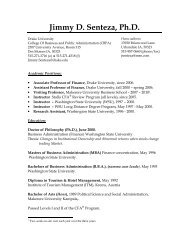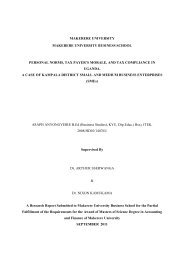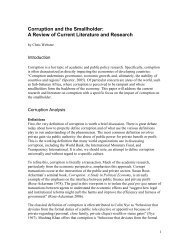13th Annual International Management Conference Proceeding
13th Annual International Management Conference Proceeding
13th Annual International Management Conference Proceeding
You also want an ePaper? Increase the reach of your titles
YUMPU automatically turns print PDFs into web optimized ePapers that Google loves.
ATTITUDES<br />
(Behavioral beliefs x<br />
Outcome evaluations)<br />
SUBJECTIVE NORMS<br />
(Normative beliefs x<br />
Motivation to comply)<br />
PERCEIVED<br />
BEHAVIOURAL<br />
CONTROL<br />
(Control beliefs x influence<br />
of control beliefs)<br />
Adopted from the Theory of Planned Behaviour (Ajzen, 1991)<br />
BEHAVIOURAL<br />
INTENTIONS<br />
The theory above can be used to explain why organizations formed without considering the natural settings<br />
that bring with them the element of social capital (trust, reciprocity, and networking) for purposes of<br />
accessing micro finance funding are failing to realize their objectives in most parts of Uganda. The original<br />
motivation is getting the funds and formation of groups is secondary. Although there is not a perfect<br />
relationship between behavioral intention and actual behaviour, intention can be used as a proximal measure<br />
of behaviour.<br />
The theory assumes that human beings are rational and make systematic use of information available to them<br />
and that people consider the implications of their actions before the decide to engage or not to engage in<br />
certain behaviors. Ajzen (1991) theorized that, intentions are a function of two basic determinants that is<br />
attitude towards behavior and subjective norms of behavior.<br />
There is clearly both scope and need for more social innovation and social entrepreneurship if, on the one<br />
hand, the identifiable requirements of the community are to be met more effectively, and, on the other hand,<br />
new opportunities to create additional benefits are to be found and exploited proactively. To accomplish<br />
this, more social champions need to be found and many of the people involved in existing ventures need to<br />
be encouraged to become more ambitious and more professional – in the context of increased efficiency.<br />
This increased incidence implies increased visibility and new forms of support. The former can be achieved<br />
by widening awareness – one key purpose of this paper and the associated research project – and the latter by<br />
introducing new training and development opportunities for people willing to support the ventures – and<br />
maybe ultimately start a new initiative. Here, the issue of the “right people” is important. Some people who<br />
are willing to volunteer their services and time may be inadequately skilled and qualified, and without<br />
appropriate training will inhibit rather than enhance the initiative.<br />
In terms of efficiencies, because many ventures of this nature can avoid the rigorous monitoring found in the<br />
profit-generating sector, it is important to ensure that the appropriate performance measures are adopted. By<br />
and large the real effectiveness of anything deemed socially entrepreneurial implies “soft” or qualitative<br />
evaluation – but quantitative measures such as the number of clients benefiting, external monies raised, the<br />
number of jobs created and the numbers of volunteers (or honorary professionals) attracted are all ideal for<br />
benchmarking purposes.<br />
In recent years the concept of social capital has been widely used in both economics and sociology.<br />
Increasingly, the significance of social capital for those interested in studying organizations in general and<br />
entrepreneurship in particular has also become apparent (Adler and Kwon, 2002; Anderson and Miller,<br />
64<br />
BEHAVIOUR
















